
Worksop is a market town in the Bassetlaw District in Nottinghamshire, England. It is located 15 miles (24 km) south of Doncaster, 15 miles (24 km) south-east of Sheffield and 24 miles (39 km) north of Nottingham. Located close to Nottinghamshire's borders with South Yorkshire and Derbyshire, it is on the River Ryton and not far from the northern edge of Sherwood Forest. Other nearby towns include Chesterfield, Gainsborough, Mansfield and Retford. The population of the town was recorded at 44,733 in the 2021 Census.
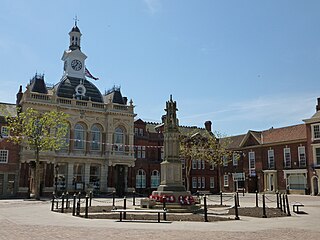
Retford, also known as East Retford, is a market town in the Bassetlaw District in Nottinghamshire, England, and one of the oldest English market towns having been granted its first charter in 1105. It lies on the River Idle and the Chesterfield Canal passes through its centre. Retford is 26 miles (42 km) east of Sheffield, 23 miles (37 km) west of Lincoln and 31 miles (50 km) north-east of Nottingham. The population at the 2021 census was 23,740.
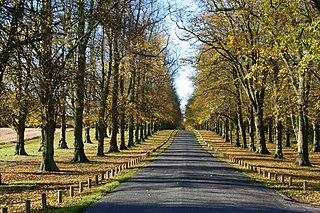
Clumber Park is a country park in The Dukeries near Worksop in Nottinghamshire, England. The estate, which was the seat of the Pelham-Clintons, Dukes of Newcastle, was purchased by the National Trust in 1946. It is listed Grade I on the Register of Historic Parks and Gardens.

Harworth is an area and former civil parish, now in the parish of Harworth Bircotes in the Bassetlaw district in Nottinghamshire, England, on the border with South Yorkshire. It is 8 miles (13 km) north of Worksop. The population of the civil parish of Harworth Bircotes was 7,948 in the 2011 Census.

Linby is a small village and civil parish in Nottinghamshire, England. The nearest town is Hucknall which is immediately to the south-west. The village grew up around the mills on the River Leen, from which Linby's name is derived. Small streams known as Linby Docks run on both sides of the main street. The population of the civil parish at the 2011 census was 232.

Manchester Cenotaph is a war memorial in St Peter's Square, Manchester, England. Manchester was late in commissioning a First World War memorial compared with most British towns and cities; the city council did not convene a war memorial committee until 1922. The committee quickly achieved its target of raising £10,000 but finding a suitable location for the monument proved controversial. The preferred site in Albert Square would have required the removal and relocation of other statues and monuments, and was opposed by the city's artistic bodies. The next choice was Piccadilly Gardens, an area already identified for a possible art gallery and library; but in the interests of speedier delivery, the memorial committee settled on St Peter's Square. The area within the square had been had been purchased by the City Council in 1906, having been the site of the former St Peter's Church; whose sealed burial crypts remained with burials untouched and marked above ground by a memorial stone cross. Negotiations to remove these stalled so the construction of the cenotaph proceeded with the cross and burials in situ.
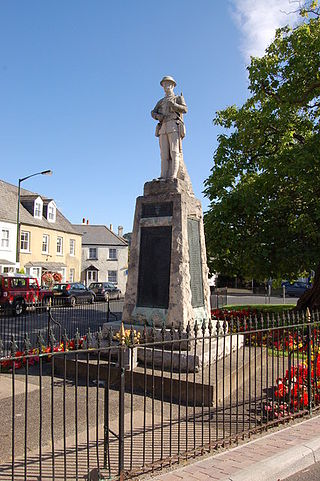
The Monmouth War Memorial commemorates the inhabitants of the town of Monmouth, Wales who died in the First and Second World Wars.

Rochdale Cenotaph is a First World War memorial on the Esplanade in Rochdale, Greater Manchester, in the north west of England. Designed by Sir Edwin Lutyens, it is one of seven memorials in England based on his Cenotaph in London and one of his more ambitious designs. The memorial was unveiled in 1922 and consists of a raised platform bearing Lutyens' characteristic Stone of Remembrance next to a 10-metre (33 ft) pylon topped by an effigy of a recumbent soldier. A set of painted stone flags surrounds the pylon.
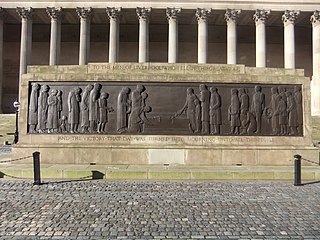
Liverpool Cenotaph stands on St George's Plateau, to the east of St George's Hall in Liverpool, England. It was erected as a memorial to those who had fallen in the First World War. The dates of the Second World War were subsequently added. The cenotaph consists of a rectangular block of stone on a stone platform, with bronze, low-relief sculptures on the sides depicting marching troops and mourners. It was designed by Lionel Budden, with carving by Herbert Tyson Smith. Initially designated as a Grade II listed building, its status was raised to Grade I in 2013.

Birkenhead War Memorial, or Birkenhead Cenotaph, stands in Hamilton Square, Birkenhead, Merseyside, England, opposite the Town Hall. It consists of a cenotaph in Portland stone with carved figures and panels in Westmorland stone. The memorial was designed by Lionel Budden, and the sculptor was H. Tyson Smith. It was unveiled in 1925 by Lieutenant-General Sir Richard H. K. Butler. The memorial is recorded in the National Heritage List for England as a designated Grade II* listed building.

The Gerrards Cross Memorial Building is a community centre and First World War memorial in the village of Gerrards Cross in Buckinghamshire, to north west of London, England. The building was designed by British architect Sir Edwin Lutyens, known for designing the Cenotaph in London and numerous other war memorials; it is the only instance of Lutyens designing a war memorial with a functional purpose, rather than as a monument in its own right.
There are 20 Grade I listed war memorials in England, out of over 3,000 listed war memorials. In the United Kingdom, a listed building is a building or structure of special historical or architectural importance; listing offers the building legal protection against demolition or modification, which requires permission from the local planning authority. Listed buildings are divided into three categories—grade I, grade II*, and grade II—which reflect the relative significance of the structure and may be a factor in planning decisions. Grade II accounts for 92% of listed buildings, while grade II* is an intermediate grade accounting for 5.5%; grade I holds the remaining 2.5% of listed buildings and is reserved for structures of exceptional significance. Grade I listed war memorials are deliberately very few, though several have been upgraded to grade I status as part of commemorations around the First World War centenary. A war memorial listed at grade I will be of exceptional interest for its design and artistic merit and will be of great historical interest. Such memorials are often the work of famous architects or sculptors, amongst the most prolific of whom was Sir Edwin Lutyens, whose memorials account for a third of all those listed at grade I. Lutyens designed dozens of war memorials across the United Kingdom and elsewhere in the Commonwealth, including the Cenotaph in London—the focus for the national Remembrance Sunday services—and the Arch of Remembrance in Leicester—the largest of Lutyens' war memorials in Britain; both are listed at grade I. As part of the commemorations of the centenary of the First World War, Historic England—the government body responsible for listing in England—is running a project with the aim of significantly increasing the number of war memorials on the National Heritage List for England.

The York City War Memorial is a First World War memorial designed by Sir Edwin Lutyens and located in York in the north of England. Proposals for commemorating York's war dead originated in 1919 but proved controversial. Initial discussions focused on whether a memorial should be a monument or should take on some utilitarian purpose. Several functional proposals were examined until a public meeting in January 1920 opted for a monument. The city engineer produced a cost estimate and the war memorial committee engaged Lutyens, who had recently been commissioned by the North Eastern Railway (NER) to design their own war memorial, also to be sited in York.
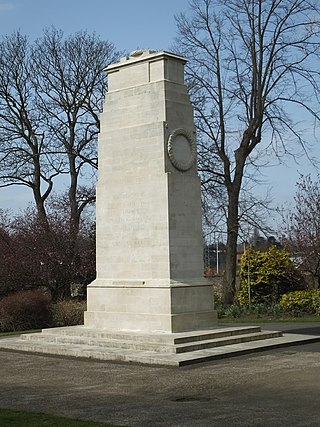
The Queen's Own Royal West Kent Regiment Cenotaph is a First World War memorial dedicated to members of the Queen's Own Royal West Kent Regiment and located in Maidstone in Kent, south-eastern England. Unveiled in 1921, the memorial was designed by Sir Edwin Lutyens following his design for the Cenotaph on Whitehall in London and is today a grade II* listed building.
The Royal Berkshire Regiment War Memorial or Royal Berkshire Regiment Cenotaph is a First World War memorial dedicated to members of the Royal Berkshire Regiment and located in Brock Barracks in Reading, Berkshire, in south-east England. Unveiled in 1921, the memorial was designed by Sir Edwin Lutyens, based on his design for the Cenotaph on Whitehall in London, and is today a grade II* listed building.

The Lancashire Fusiliers War Memorial is a First World War memorial dedicated to members of the Lancashire Fusiliers killed in that conflict. Outside the Fusilier Museum in Bury, Greater Manchester, in North West England, it was unveiled in 1922—on the seventh anniversary of the landing at Cape Helles, part of the Gallipoli Campaign in which the regiment suffered particularly heavy casualties. The memorial was designed by Sir Edwin Lutyens. Lutyens was commissioned in light of a family connection—his father and great uncle were officers in the Lancashire Fusiliers, a fact noted on a plaque nearby. He designed a tall, slender obelisk in Portland stone. The regiment's cap badge is carved near the top on the front and rear, surrounded by a laurel wreath. Further down are inscriptions containing the regiment's motto and a dedication. Two painted stone flags hang from the sides.

Croydon Cenotaph is a war memorial, in Croydon, London, England. It is located outside the Croydon Clocktower arts complex, on Katharine Street in Croydon.

Clumber and Hardwick is a civil parish in the Bassetlaw district, in the county of Nottinghamshire, England. The parish includes the settlement of Hardwick Village and Clumber Park, a country park. In 2011 the parish had a population of 198. The parish lies in the north west of the county, and south west within the district. It is 125 miles north west of London, 22 miles north of the city of Nottingham, and 3½ miles south east of the market town of Worksop.The parish touches Babworth, Carburton, Elkesley, Perlethorpe cum Budby and Welbeck. The parish was formed on 1 April 1994. The area is within Sherwood Forest and has close historical associations with the Dukes of Newcastle, being part of a wider region known as The Dukeries. There are 26 listed buildings in Clumber and Hardwick.
Worksop is a market town in the Bassetlaw District of Nottinghamshire, England. The town contains over 100 listed buildings that are recorded in the National Heritage List for England. Of these, four are listed at Grade I, the highest of the three grades, five are at Grade II*, the middle grade, and the others are at Grade II, the lowest grade. The most important listed buildings are a former priory, later a parish church, the gatehouse to the priory, a lodge, and a country house, which are listed at Grade I, and structures associated with them are also listed. Most of the other listed buildings include houses, cottages and associated structures, shops, offices, farmhouses and farm buildings, public houses and hotels, public buildings and churches. The rest of the listed buildings include a market cross, a canal lock, schools, a bank, a railway station and a signal box, a pumping station, war memorials and a telephone kiosk.

















